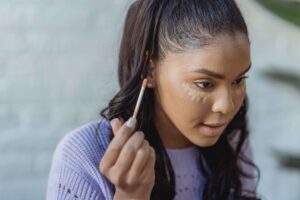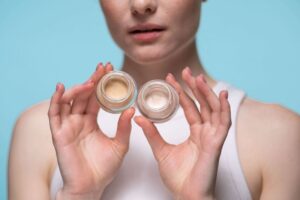The Concealer Code

Concealer, the unsung hero of the beauty world, has the power to transform your look by camouflaging imperfections, brightening the under-eye area, and achieving a flawless complexion. However, the key to unlocking its full potential lies in mastering the art of shade matching. In this guide, we dive into the nuances of concealer selection, offering tips and insights to help you gain concealer confidence and achieve seamless, natural-looking coverage.
Concealer is a versatile cosmetic designed to address specific skin concerns, such as blemishes, dark circles, redness, and uneven pigmentation. Unlike foundation, which provides overall coverage confidence, concealer allows for targeted application, making it an essential tool for achieving a polished and perfected makeup look.
1. Determining Your Undertone
Understanding your undertone is the foundation of successful shade matching. Undertones fall into three main categories: warm, cool, and neutral.
- Warm Undertones: If you have a warm undertone, your skin might have a peachy, golden, or yellow hue.
- Cool Undertones: A cool undertone is characterized by pink, red, or blue hues in the skin.
- Neutral Undertones: If your undertone is neutral, you have a balance of warm and cool tones, allowing for flexibility in shade selection.
To identify your undertone, examine the veins on your wrist. If they appear greenish, you likely have warm undertones. If they appear bluish, you may have cool undertones. Neutral undertones often exhibit a mix of both.
2. Finding the Right Shade
When selecting a concealer shade, consider both your skin tone and the specific concerns you want to address:
- Matching Your Skin Tone: Choose a concealer shade that closely matches your skin tone for blemish coverage or an even complexion.
- Brightening the Under-Eye Area: Opt for a concealer that is one to two shades lighter than your skin tone to illuminate and lift the under-eye area.
- Color-Correcting: For specific concerns like redness or dark circles, you may need different shades. A peach or salmon-toned concealer can counteract dark circles, while a green concealer can neutralize redness.
3. Testing in Natural Light
The importance of testing concealer shades in natural light cannot be overstated. Artificial lighting in stores can be deceiving, and swatching on your wrist may not provide an accurate representation. Apply a small amount of concealer to the area you intend to cover, step outside, and assess the shade in natural light. This step ensures a seamless blend and prevents the dreaded “mask” effect.
4. Consider the Formula
Concealers come in various formulations, from liquid to cream to stick. The formula you choose should not only match your skin tone but also cater to your skin type:
- Liquid Concealers: Ideal for most skin types, liquid concealers offer buildable coverage and are often hydrating. They work well for both under-eye and blemish coverage.
- Cream Concealers: Creamy concealers are excellent for dry skin, providing a hydrating and dewy finish. They may be thicker in consistency, offering fuller coverage.
- Stick Concealers: Stick concealers are convenient for on-the-go touch-ups and often provide a matte finish. They work well for oily or combination skin.
5. Invest in Quality Tools
The tools you use can significantly impact the application and blending of concealer:
- Concealer Brush: A small, synthetic concealer brush allows for precise application, especially when targeting blemishes or specific areas. It provides control and prevents overapplication.
- Makeup Sponge: Dampen a makeup sponge to blend concealer seamlessly into the skin. The sponge’s soft texture ensures a natural finish, particularly when working with liquid or cream formulations.
- Fingers: Your fingers can be effective tools, especially when applying concealer to the under-eye area. The warmth of your fingers helps melt the product into the skin for a smooth, natural look.
6. Customize Your Approach
Achieving the perfect concealer shade may involve a bit of customization. Consider layering or mixing different shades to address varying concerns on your face. For example, use a slightly lighter shade in the inner corners of your eyes to enhance brightness.
7. Evolving with the Seasons
Your skin tone can fluctuate with the seasons due to sun exposure or changes in overall complexion. It’s essential to reassess your concealer shade periodically and adjust accordingly. Having a couple of shades on hand for different seasons ensures you always have the perfect match.

8. Embrace the No-Makeup Look Confidence
Concealer’s versatility extends beyond traditional makeup application. Embrace the no-makeup look by using concealer strategically:
- Spot Treatment: Ditching foundation? Use concealer to spot-treat specific areas, providing coverage only where needed.
- Natural Highlighting: Opt for a slightly lighter concealer shade on the high points of your face—cheekbones, bridge of the nose, and cupid’s bow—for a subtle, natural highlight.
- Quick Fixes: In a rush? Concealer can be your go-to for quick fixes. Cover blemishes, even out your skin tone, and brighten your under-eye area for an instant boost.
Mastering the art of concealer shade matching is a journey of self-discovery, experimentation, and, most importantly, self-acceptance. Embrace the process of finding your perfect match, recognizing that makeup is a form of self-expression. With the right shade, application techniques, and a touch of confidence, you can unlock the transformative power of concealer, celebrating your natural beauty and radiating confidence in every shade.

